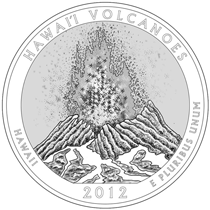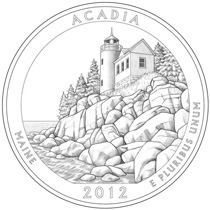
Hawai’i Volcanoes National Park quarter design
On December 8, 2011, the U.S. Mint unveiled the final design for the 2012 Hawai’i Volcanoes National Park quarter. As the 4th release of the year, the Hawaii quarter will feature the east rift of the Kilauea Volcano. Kilauea rises 4,190 feet above sea level and is located on the south side of Mauna Loa. It is one of the world’s most active volcanoes. To learn more about this amazing volcano check out the US Geological Survey.
The east rift extends, as a ridge, nearly 80 miles from the caldera (large crater) to the ocean floor. Along the ridge are numerous vents from which lava erupts and spews. In fact, Kilauea means spewing or much spreading.
Created by U.S. Mint engraver Charles L. Vickers, the image of the volcano on the reverse is one of the more modernistic designs. The reverse inscriptions include the name of the site: hawai’i volcanoes, the year of issue: 2012 and the motto: e pluribus unum and the state.
This handsome quarter is a perfect match for the 2008 Statehood quarter, which also featured Hawaii, the park’s home state. As 14th in the series overall, the Hawaii quarter will be followed by the Denali National Park issue, the final coin for 2012.




